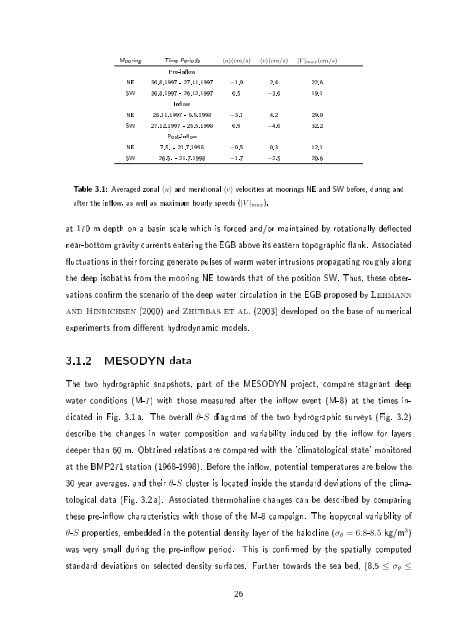Baltic Sea
Baltic Sea
Baltic Sea
You also want an ePaper? Increase the reach of your titles
YUMPU automatically turns print PDFs into web optimized ePapers that Google loves.
Mooring Time Periods 〈u〉(cm/s) 〈v〉(cm/s) |V | max(cm/s)<br />
Pre-inow<br />
NE 30.8.1997 - 27.11.1997 −1.9 2.4 22.6<br />
SW 30.8.1997 - 26.12.1997 0.5 −3.0 19.1<br />
Inow<br />
NE 28.11.1997 - 6.5.1998 −3.1 4.2 29.0<br />
SW 27.12.1997 - 25.5.1998 0.9 −4.0 32.2<br />
Post-inow<br />
NE 7.5. - 21.7.1998 −0.5 0.3 12.1<br />
SW 26.5. - 21.7.1998 −1.7 −2.5 20.6<br />
Table 3.1: Averaged zonal 〈u〉 and meridional 〈v〉 velocities at moorings NE and SW before, during and<br />
after the inow, as well as maximum hourly speeds (|V | max ).<br />
at 170 m depth on a basin scale which is forced and/or maintained by rotationally deected<br />
near-bottom gravity currents entering the EGB above its eastern topographic ank. Associated<br />
uctuations in their forcing generate pulses of warm water intrusions propagating roughly along<br />
the deep isobaths from the mooring NE towards that of the position SW. Thus, these observations<br />
conrm the scenario of the deep water circulation in the EGB proposed by Lehmann<br />
and Hinrichsen (2000) and Zhurbas et al. (2003) developed on the base of numerical<br />
experiments from dierent hydrodynamic models.<br />
3.1.2 MESODYN data<br />
The two hydrographic snapshots, part of the MESODYN project, compare stagnant deep<br />
water conditions (M-7) with those measured after the inow event (M-8) at the times indicated<br />
in Fig. 3.1 a. The overall θ-S diagrams of the two hydrographic surveys (Fig. 3.2)<br />
describe the changes in water composition and variability induced by the inow for layers<br />
deeper than 60 m. Obtained relations are compared with the 'climatological state' monitored<br />
at the BMP271 station (1968-1998). Before the inow, potential temperatures are below the<br />
30 year averages, and their θ-S cluster is located inside the standard deviations of the climatological<br />
data (Fig. 3.2 a). Associated thermohaline changes can be described by comparing<br />
these pre-inow characteristics with those of the M-8 campaign. The isopycnal variability of<br />
θ-S properties, embedded in the potential density layer of the halocline (σ θ = 6.8-8.5 kg/m 3 )<br />
was very small during the pre-inow period. This is conrmed by the spatially computed<br />
standard deviations on selected density surfaces. Further towards the sea bed, (8.5 ≤ σ θ ≤<br />
26



